Siyuan Feng
ReSpec: Towards Optimizing Speculative Decoding in Reinforcement Learning Systems
Oct 30, 2025Abstract:Adapting large language models (LLMs) via reinforcement learning (RL) is often bottlenecked by the generation stage, which can consume over 75\% of the training time. Speculative decoding (SD) accelerates autoregressive generation in serving systems, but its behavior under RL training remains largely unexplored. We identify three critical gaps that hinder the naive integration of SD into RL systems: diminishing speedups at large batch sizes, drafter staleness under continual actor updates, and drafter-induced policy degradation. To address these gaps, we present ReSpec, a system that adapts SD to RL through three complementary mechanisms: dynamically tuning SD configurations, evolving the drafter via knowledge distillation, and weighting updates by rollout rewards. On Qwen models (3B--14B), ReSpec achieves up to 4.5x speedup while preserving reward convergence and training stability, providing a practical solution for efficient RL-based LLM adaptation.
Geometry-aware 4D Video Generation for Robot Manipulation
Jul 01, 2025Abstract:Understanding and predicting the dynamics of the physical world can enhance a robot's ability to plan and interact effectively in complex environments. While recent video generation models have shown strong potential in modeling dynamic scenes, generating videos that are both temporally coherent and geometrically consistent across camera views remains a significant challenge. To address this, we propose a 4D video generation model that enforces multi-view 3D consistency of videos by supervising the model with cross-view pointmap alignment during training. This geometric supervision enables the model to learn a shared 3D representation of the scene, allowing it to predict future video sequences from novel viewpoints based solely on the given RGB-D observations, without requiring camera poses as inputs. Compared to existing baselines, our method produces more visually stable and spatially aligned predictions across multiple simulated and real-world robotic datasets. We further show that the predicted 4D videos can be used to recover robot end-effector trajectories using an off-the-shelf 6DoF pose tracker, supporting robust robot manipulation and generalization to novel camera viewpoints.
LLM-ODDR: A Large Language Model Framework for Joint Order Dispatching and Driver Repositioning
May 28, 2025Abstract:Ride-hailing platforms face significant challenges in optimizing order dispatching and driver repositioning operations in dynamic urban environments. Traditional approaches based on combinatorial optimization, rule-based heuristics, and reinforcement learning often overlook driver income fairness, interpretability, and adaptability to real-world dynamics. To address these gaps, we propose LLM-ODDR, a novel framework leveraging Large Language Models (LLMs) for joint Order Dispatching and Driver Repositioning (ODDR) in ride-hailing services. LLM-ODDR framework comprises three key components: (1) Multi-objective-guided Order Value Refinement, which evaluates orders by considering multiple objectives to determine their overall value; (2) Fairness-aware Order Dispatching, which balances platform revenue with driver income fairness; and (3) Spatiotemporal Demand-Aware Driver Repositioning, which optimizes idle vehicle placement based on historical patterns and projected supply. We also develop JointDR-GPT, a fine-tuned model optimized for ODDR tasks with domain knowledge. Extensive experiments on real-world datasets from Manhattan taxi operations demonstrate that our framework significantly outperforms traditional methods in terms of effectiveness, adaptability to anomalous conditions, and decision interpretability. To our knowledge, this is the first exploration of LLMs as decision-making agents in ride-hailing ODDR tasks, establishing foundational insights for integrating advanced language models within intelligent transportation systems.
Genie Centurion: Accelerating Scalable Real-World Robot Training with Human Rewind-and-Refine Guidance
May 24, 2025



Abstract:While Vision-Language-Action (VLA) models show strong generalizability in various tasks, real-world deployment of robotic policy still requires large-scale, high-quality human expert demonstrations. However, passive data collection via human teleoperation is costly, hard to scale, and often biased toward passive demonstrations with limited diversity. To address this, we propose Genie Centurion (GCENT), a scalable and general data collection paradigm based on human rewind-and-refine guidance. When the robot execution failures occur, GCENT enables the system revert to a previous state with a rewind mechanism, after which a teleoperator provides corrective demonstrations to refine the policy. This framework supports a one-human-to-many-robots supervision scheme with a Task Sentinel module, which autonomously predicts task success and solicits human intervention when necessary, enabling scalable supervision. Empirical results show that GCENT achieves up to 40% higher task success rates than state-of-the-art data collection methods, and reaches comparable performance using less than half the data. We also quantify the data yield-to-effort ratio under multi-robot scenarios, demonstrating GCENT's potential for scalable and cost-efficient robot policy training in real-world environments.
PolyTouch: A Robust Multi-Modal Tactile Sensor for Contact-rich Manipulation Using Tactile-Diffusion Policies
Apr 27, 2025Abstract:Achieving robust dexterous manipulation in unstructured domestic environments remains a significant challenge in robotics. Even with state-of-the-art robot learning methods, haptic-oblivious control strategies (i.e. those relying only on external vision and/or proprioception) often fall short due to occlusions, visual complexities, and the need for precise contact interaction control. To address these limitations, we introduce PolyTouch, a novel robot finger that integrates camera-based tactile sensing, acoustic sensing, and peripheral visual sensing into a single design that is compact and durable. PolyTouch provides high-resolution tactile feedback across multiple temporal scales, which is essential for efficiently learning complex manipulation tasks. Experiments demonstrate an at least 20-fold increase in lifespan over commercial tactile sensors, with a design that is both easy to manufacture and scalable. We then use this multi-modal tactile feedback along with visuo-proprioceptive observations to synthesize a tactile-diffusion policy from human demonstrations; the resulting contact-aware control policy significantly outperforms haptic-oblivious policies in multiple contact-aware manipulation policies. This paper highlights how effectively integrating multi-modal contact sensing can hasten the development of effective contact-aware manipulation policies, paving the way for more reliable and versatile domestic robots. More information can be found at https://polytouch.alanz.info/
Unified World Models: Coupling Video and Action Diffusion for Pretraining on Large Robotic Datasets
Apr 03, 2025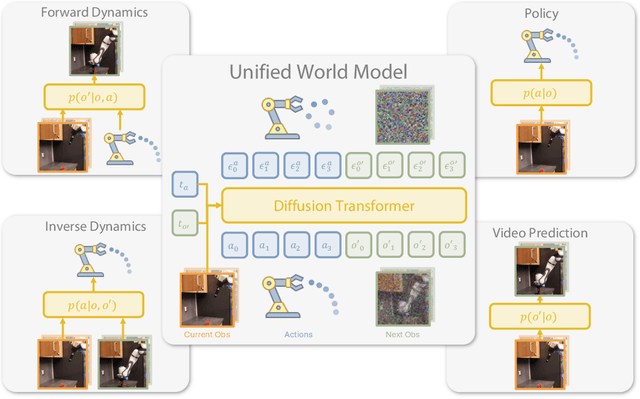
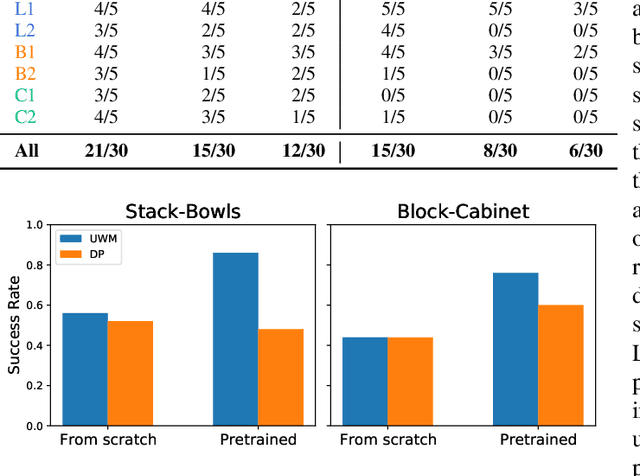
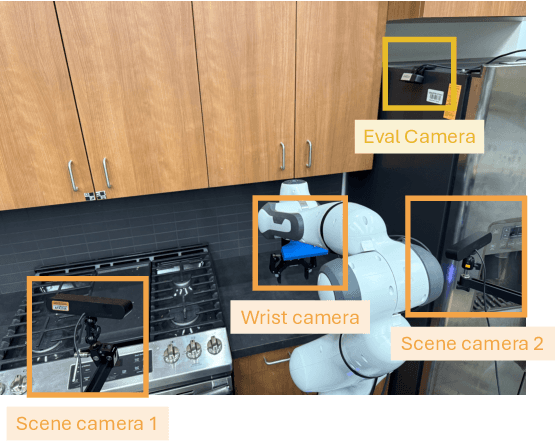
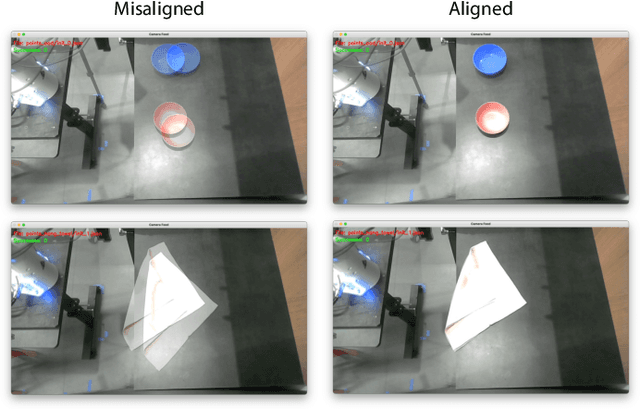
Abstract:Imitation learning has emerged as a promising approach towards building generalist robots. However, scaling imitation learning for large robot foundation models remains challenging due to its reliance on high-quality expert demonstrations. Meanwhile, large amounts of video data depicting a wide range of environments and diverse behaviors are readily available. This data provides a rich source of information about real-world dynamics and agent-environment interactions. Leveraging this data directly for imitation learning, however, has proven difficult due to the lack of action annotation required for most contemporary methods. In this work, we present Unified World Models (UWM), a framework that allows for leveraging both video and action data for policy learning. Specifically, a UWM integrates an action diffusion process and a video diffusion process within a unified transformer architecture, where independent diffusion timesteps govern each modality. We show that by simply controlling each diffusion timestep, UWM can flexibly represent a policy, a forward dynamics, an inverse dynamics, and a video generator. Through simulated and real-world experiments, we show that: (1) UWM enables effective pretraining on large-scale multitask robot datasets with both dynamics and action predictions, resulting in more generalizable and robust policies than imitation learning, (2) UWM naturally facilitates learning from action-free video data through independent control of modality-specific diffusion timesteps, further improving the performance of finetuned policies. Our results suggest that UWM offers a promising step toward harnessing large, heterogeneous datasets for scalable robot learning, and provides a simple unification between the often disparate paradigms of imitation learning and world modeling. Videos and code are available at https://weirdlabuw.github.io/uwm/.
Adversarial Data Collection: Human-Collaborative Perturbations for Efficient and Robust Robotic Imitation Learning
Mar 14, 2025



Abstract:The pursuit of data efficiency, where quality outweighs quantity, has emerged as a cornerstone in robotic manipulation, especially given the high costs associated with real-world data collection. We propose that maximizing the informational density of individual demonstrations can dramatically reduce reliance on large-scale datasets while improving task performance. To this end, we introduce Adversarial Data Collection, a Human-in-the-Loop (HiL) framework that redefines robotic data acquisition through real-time, bidirectional human-environment interactions. Unlike conventional pipelines that passively record static demonstrations, ADC adopts a collaborative perturbation paradigm: during a single episode, an adversarial operator dynamically alters object states, environmental conditions, and linguistic commands, while the tele-operator adaptively adjusts actions to overcome these evolving challenges. This process compresses diverse failure-recovery behaviors, compositional task variations, and environmental perturbations into minimal demonstrations. Our experiments demonstrate that ADC-trained models achieve superior compositional generalization to unseen task instructions, enhanced robustness to perceptual perturbations, and emergent error recovery capabilities. Strikingly, models trained with merely 20% of the demonstration volume collected through ADC significantly outperform traditional approaches using full datasets. These advances bridge the gap between data-centric learning paradigms and practical robotic deployment, demonstrating that strategic data acquisition, not merely post-hoc processing, is critical for scalable, real-world robot learning. Additionally, we are curating a large-scale ADC-Robotics dataset comprising real-world manipulation tasks with adversarial perturbations. This benchmark will be open-sourced to facilitate advancements in robotic imitation learning.
WHERE-Bot: a Wheel-less Helical-ring Everting Robot Capable of Omnidirectional Locomotion
Mar 10, 2025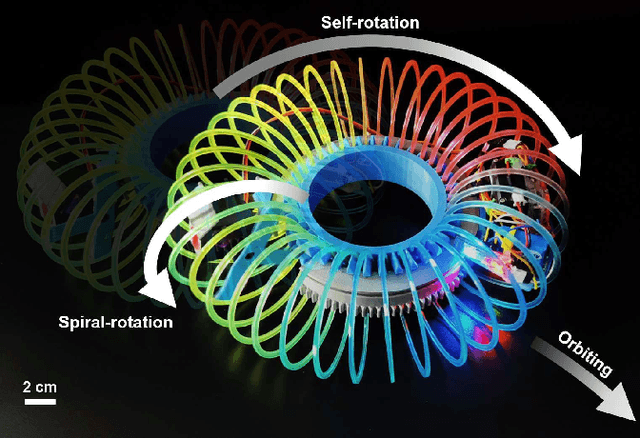
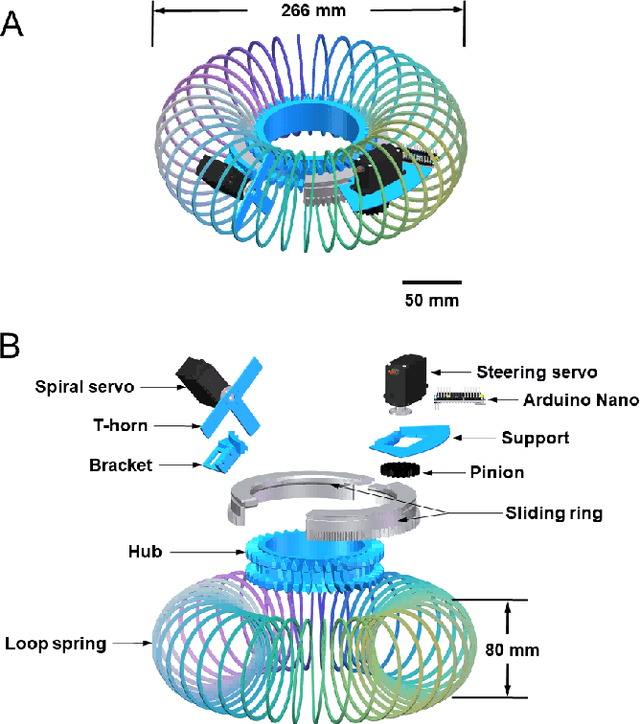
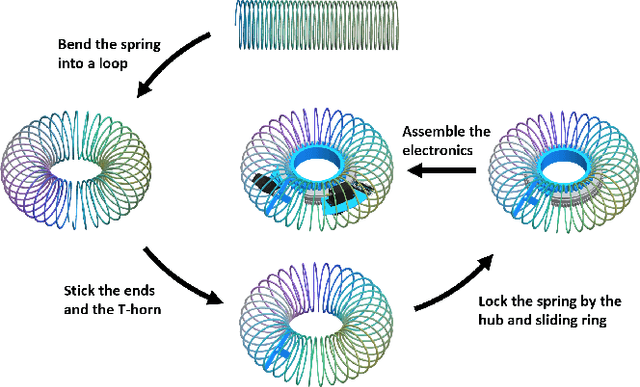
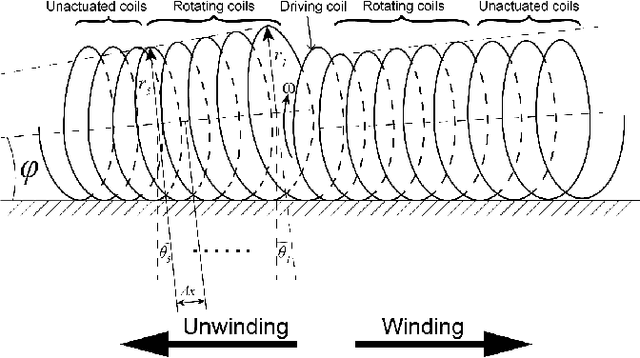
Abstract:Compared to conventional wheeled transportation systems designed for flat surfaces, soft robots exhibit exceptional adaptability to various terrains, enabling stable movement in complex environments. However, due to the risk of collision with obstacles and barriers, most soft robots rely on sensors for navigation in unstructured environments with uncertain boundaries. In this work, we present the WHERE-Bot, a wheel-less everting soft robot capable of omnidirectional locomotion. Our WHERE-Bot can navigate through unstructured environments by leveraging its structural and motion advantages rather than relying on sensors for boundary detection. By configuring a spring toy ``Slinky'' into a loop shape, the WHERE-Bot performs multiple rotational motions: spiral-rotating along the hub circumference, self-rotating around the hub's center, and orbiting around a certain point. The robot's trajectories can be reprogrammed by actively altering its mass distribution. The WHERE-Bot shows significant potential for boundary exploration in unstructured environments.
AgiBot World Colosseo: A Large-scale Manipulation Platform for Scalable and Intelligent Embodied Systems
Mar 09, 2025Abstract:We explore how scalable robot data can address real-world challenges for generalized robotic manipulation. Introducing AgiBot World, a large-scale platform comprising over 1 million trajectories across 217 tasks in five deployment scenarios, we achieve an order-of-magnitude increase in data scale compared to existing datasets. Accelerated by a standardized collection pipeline with human-in-the-loop verification, AgiBot World guarantees high-quality and diverse data distribution. It is extensible from grippers to dexterous hands and visuo-tactile sensors for fine-grained skill acquisition. Building on top of data, we introduce Genie Operator-1 (GO-1), a novel generalist policy that leverages latent action representations to maximize data utilization, demonstrating predictable performance scaling with increased data volume. Policies pre-trained on our dataset achieve an average performance improvement of 30% over those trained on Open X-Embodiment, both in in-domain and out-of-distribution scenarios. GO-1 exhibits exceptional capability in real-world dexterous and long-horizon tasks, achieving over 60% success rate on complex tasks and outperforming prior RDT approach by 32%. By open-sourcing the dataset, tools, and models, we aim to democratize access to large-scale, high-quality robot data, advancing the pursuit of scalable and general-purpose intelligence.
Understanding the Impact of Confidence in Retrieval Augmented Generation: A Case Study in the Medical Domain
Dec 29, 2024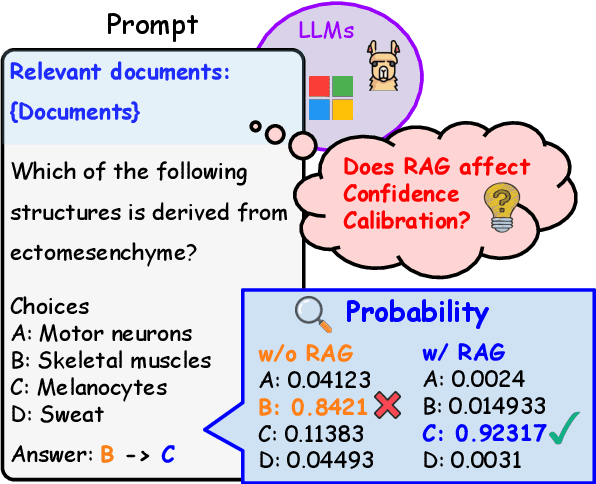

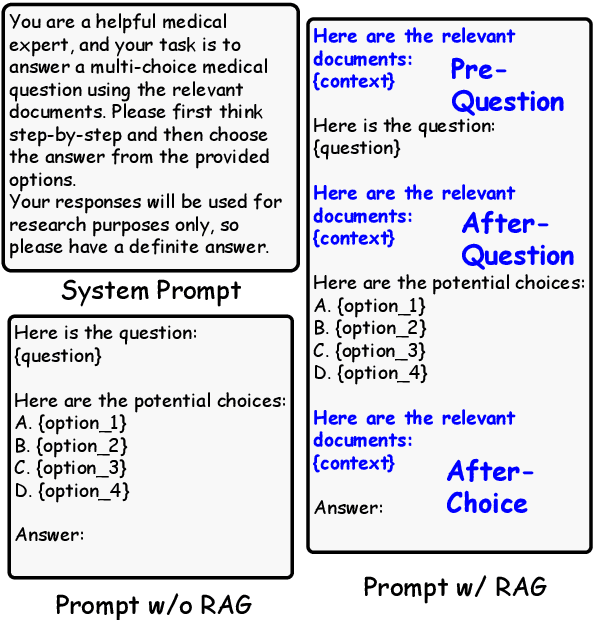
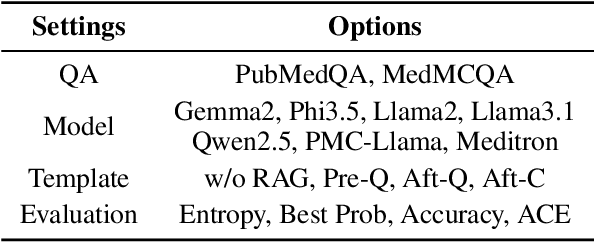
Abstract:Retrieval Augmented Generation (RAG) complements the knowledge of Large Language Models (LLMs) by leveraging external information to enhance response accuracy for queries. This approach is widely applied in several fields by taking its advantage of injecting the most up-to-date information, and researchers are focusing on understanding and improving this aspect to unlock the full potential of RAG in such high-stakes applications. However, despite the potential of RAG to address these needs, the mechanisms behind the confidence levels of its outputs remain underexplored, although the confidence of information is very critical in some domains, such as finance, healthcare, and medicine. Our study focuses the impact of RAG on confidence within the medical domain under various configurations and models. We evaluate confidence by treating the model's predicted probability as its output and calculating Expected Calibration Error (ECE) and Adaptive Calibration Error (ACE) scores based on the probabilities and accuracy. In addition, we analyze whether the order of retrieved documents within prompts calibrates the confidence. Our findings reveal large variation in confidence and accuracy depending on the model, settings, and the format of input prompts. These results underscore the necessity of optimizing configurations based on the specific model and conditions.
 Add to Chrome
Add to Chrome Add to Firefox
Add to Firefox Add to Edge
Add to Edge